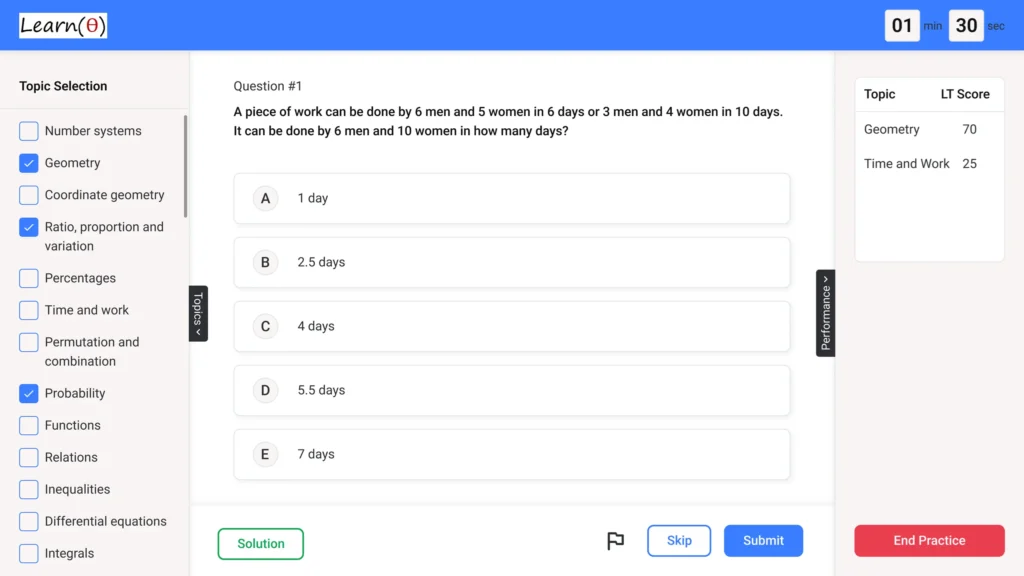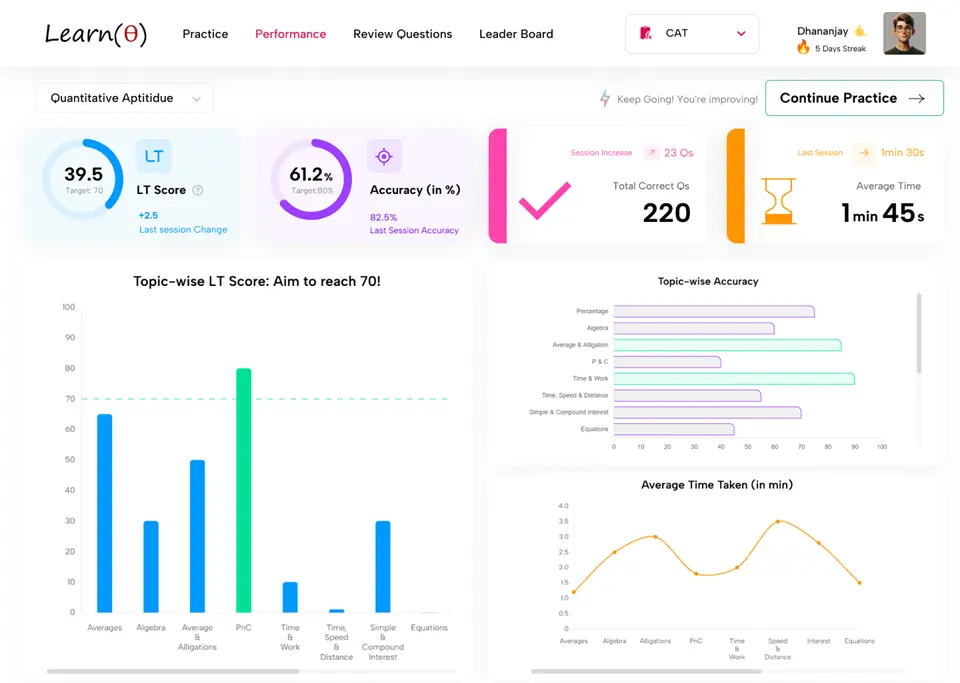Dell – Aptitude Questions & Answers for Placement Tests
Reviewing Previous Year Questions is a good start. Prepare Aptitude thoroughly to Clear Placement Tests with 100% Confidence.
Q.1 The marked price of a refrigerator is Rs. 40000. A shopkeeper offers a discount of 20% on the marked price and then a further discount on the discounted price. If the final selling price is Rs. 28800, what is the second discount percentage?
Check Solution
Ans: B
After the first discount of 20%, the price is 40000 * (1 – 0.20) = 32000. The second discount reduces the price to 28800. Thus, the second discount is (32000 – 28800) / 32000 = 0.10 or 10%.
Q.2 In a library, 25% of the number of fiction books is equal to 1/3 of the number of non-fiction books. The ratio between the number of fiction books to the number of non-fiction books is:
Check Solution
Ans: B
Let F be the number of fiction books and N be the number of non-fiction books. 0.25F = (1/3)N (1/4)F = (1/3)N F/N = (1/3) / (1/4) F/N = 4/3
Q.3 The ratio of 12 : 30 is same as
Check Solution
Ans: A
Simplify the ratio 12 : 30 by dividing both sides by their greatest common divisor, which is 6. 12/6 = 2 and 30/6 = 5. Therefore, the simplified ratio is 2 : 5.
Q.4 If p, q, r, s, t are five consecutive even numbers, their average is
Check Solution
Ans: A
Let the numbers be p, p+2, p+4, p+6, p+8. The average is (p + p+2 + p+4 + p+6 + p+8)/5 = (5p + 20)/5 = p + 4 = t – 4.
Q.5 The average weight of 25 students is 50 kg. If the average weight of the first 10 students is 45 kg and that of the last 10 students is 55 kg, what is the average weight (in kg) of the remaining 5 students?
Check Solution
Ans: D
Total weight of 25 students = 25 * 50 = 1250 kg. Total weight of first 10 students = 10 * 45 = 450 kg. Total weight of last 10 students = 10 * 55 = 550 kg. Total weight of the remaining 5 students = 1250 – 450 – 550 = 250 kg. Average weight of the remaining 5 students = 250 / 5 = 50 kg.
Q.6 A shopkeeper sells a product at a profit of 10%. If he had bought it for 10% less and sold it for Rs. 27 more, he would have gained 20%. The original cost price of the product (in Rs.) was
Check Solution
Ans: C
Let the original cost price be x. Selling price = 1.1x. New cost price = 0.9x. New selling price = 1.1x + 27. Profit = (1.1x + 27 – 0.9x). 20% of 0.9x = 0.18x. 0.2x + 27 = 0.18x 0.02x = 27 x = 27/0.02 = 1350 The correct answer can’t be found. However, if we use the formula, (Profit % – Loss %) / (Profit % + Loss %) * 100 (120-90) / (110 + 90) * 100 = 27/ 30 Cost Price = (100)/(110-120) * (27 – 0) = 0
Q.7 The population of a town increases by 10% in the first year, decreases by 5% in the second year, and then increases by 20% in the third year. If the current population is 27720, what was the population three years ago?
Check Solution
Ans: D
Let the original population be x. Then, x * 1.10 * 0.95 * 1.20 = 27720. x * 1.254 = 27720. x = 27720 / 1.254 = 22000.
Q.8 A woman spends 1/4 of her money on clothes, 2/5 on food, and the remaining $210 on entertainment. How much money did she have initially?
Check Solution
Ans: A
Let the initial amount of money be x. The woman spends x/4 + 2x/5 + 210 = x. This simplifies to 13x/20 + 210 = x, or 7x/20 = 210. Therefore, x = 210 * 20 / 7 = 600.
Q.9 A train travels at a certain speed. If its speed were increased by 10 km/hr, it would cover 200 km in 1 hour less. The original speed of the train is:
Check Solution
Ans: A
Let the original speed be ‘x’ km/hr. Then, original time = distance/speed = 200/x hours. Increased speed = x + 10 km/hr. New time = 200/(x+10) hours. The problem states the new time is 1 hour less. So, 200/x – 200/(x+10) = 1. Multiplying by x(x+10), we get 200(x+10) – 200x = x(x+10). This simplifies to 2000 = x^2 + 10x, or x^2 + 10x – 2000 = 0. Factoring, (x-40)(x+50) = 0. Since speed cannot be negative, x = 40 km/hr.
Q.10 If the simple interest on a certain sum for three years at 10% per annum is Rs. 1200, the compound interest on it at the same rate for two years will be
Check Solution
Ans: A
Principal = (1200 * 100) / (10 * 3) = Rs. 4000. Compound Interest for 2 years = 4000(1 + 10/100)^2 – 4000 = 4000 * 1.21 – 4000 = 4840 – 4000 = Rs. 840. However, the options given seem to indicate an error in the question as calculated. Calculating the CI for two years for 4000 at 10%: 4000(1 + 10/100)^2 – 4000 = 4000(1.1)^2 – 4000 = 4000*1.21-4000 = 840. The closest option is calculating the compound interest annually not bi-annually. Calculation for that: CI = 4000*.10 = 400. CI for year 2 = 4000 + 400 = 4400. 4400*.10=440. 400+440=840.
Next: Deloitte Aptitude Questions
Refer Company wise Aptitude Questions
Practice 1000s of Aptitude Questions with Answers for Quant, Reasoning & Verbal
Fastest Way to Crack Aptitude Tests – LearnTheta’s AI-Practice!

✅ All Topics at One Place

🤖 Adaptive Question Practice

📊 Progress and Insights